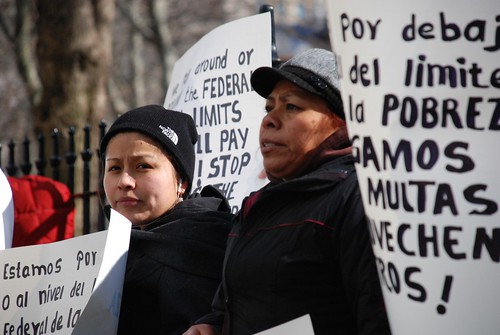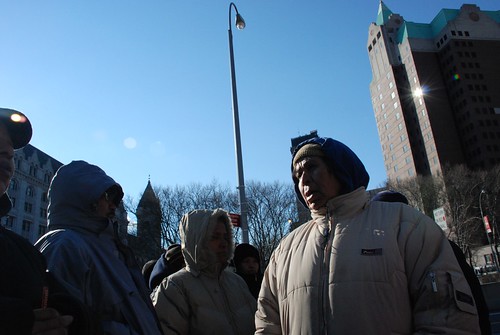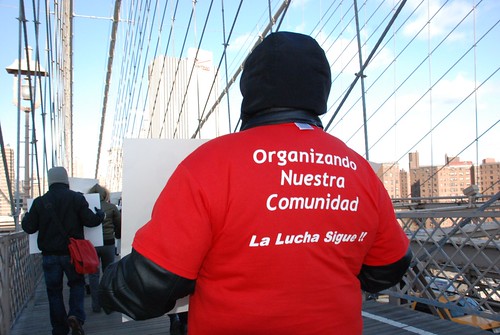By Tony Paterson in Berlin
Saturday, 3 July 2010
With Germany fielding its most ethnically mixed World Cup side on record, the country's immigrant Turkish and Arab population is showing unprecedented support for the national 11 by flying Germany's red, black and gold flags from cars, restaurants and businesses.
But while the display of patriotic fervour has been welcomed by Chancellor Angela Merkel's government as a sign of long-awaited "positive integration", it has infuriated Germany's radical leftwing anarchist scene which has begun a war against flag-flying immigrants.
Several German anarchist publications have denounced the flags as "Black red and gold rags" which encourage "dangerous nationalist tendencies". So-called "anarchist commandos" have raided Turkish and Arab businesses in Berlin, either ripping down or burning football flags on public display.
Ibrahim Bassal, a German of Arab descent who owns a mobile phone shop in Berlin's ethnically mixed Neukölln district, started hanging a 50ft German tricolour from the top of his shop building when the World Cup began. The flag has been torn down several times and once an unknown assailant set fire to it in the early hours of the morning.
Mr Bassal said that before the attacks, a group of 16 aggressive, black-clad young Germans entered his shop and accused him of "arousing Nazi sympathies" with his flag. "We have been living in and working in Germany for decades and our children were born here," Mr Bassal complained earlier this week. "Of course we support Germany. What's that got to do with Nazis? What's the problem?"
Scores of other Berliners with Turkish and Arab roots have complained of similar attacks in which flags have been torn off cars or shop fronts and sometimes shredded or burned. A group calling itself "Kommando Kevin-Prince Boateng" has indirectly claimed responsibility for the flag war after posting a notice on the Indymedia website calling for the "capture" of German flags. Boateng, a Portsmouth midfielder playing for Ghana in the World Cup, put German team captain Michael Ballack (Chelsea) out of the tournament with a foul in May's FA Cup final.
The anarchists' reaction is not new. Berlin's radical left-wing activists launched similar campaigns in 2006 when Germany was hosting the World Cup. They stole hundreds of flags in the city's Friedrichshain district and pelted soccer supporters with water bombs.
During the 2008 European championships German flags were stolen, shredded and hung from lampposts as anarchist "trophies". However this tournament marks the first time that immigrants have been targeted for flying the German flag. "They see us as immigrants," Mr Bassal said of the anarchists. "They don't understand that Germans who aren't from Germany support the national side." While much of that support stems from the fact that Turkey, the country of Germany's largest, 1.7 million- strong, immigrant group, is not playing in the contest, the huge backing given to the side by Germans with Turkish and Arab roots is undoubtedly due to the ethnic mix of the players.
The German squad has a higher number of players from diverse ethnic background than at any time in its history. Around half the players were born abroad, have parents who were born abroad or have one non-German parent. One of the side's biggest stars is Mesut Ozil, the son of Turkish parents whose goal sent Germany through to the second round of the World Cup. The enthusiasm for Ozil was on show during the Germany-England game last Sunday, when hundreds of Berlin's Turkish residents flocked to the city's football fan mile draped in German national flags. Commentators have noted that half of the German current side would have not have been allowed to compete little more than a decade ago because the country's strict citizenship laws, which used to be based on "German blood ties", would have barred them.
Yet when it comes to national sporting highlights such as tonight's Germany-Argentina showdown, immigrants like Berlin's Ibrahim Bassal remain defiant. A neighbourhood "flag watch" has been set up in his district to safeguard the honour of the German tricolour hanging from his building. "We won't let our pride be taken away," he insists.
Jul 6, 2010
Why Germany's immigrants fly the flag for their adopted country - World Cup, Football
May 18, 2010
May 10, 2010
May 2, 2010
Aug 17, 2009
Axitia Mode 09.19.09

A few things to check out here on the Axitia Mode-ality: 1) this flyer for an upcoming event.
2) Radio Broadcasting:
and the supplemental info:
http://www.myspace.com/axitiamode
http://twitter.com/axitiamode
Labels: axitia, belwether, Dreams, Frankenstein, Gridley California, KZFR, luiseño, Luiseño Moda Musica, Radio Luiseño
Apr 25, 2009
via dr. frankenstien
FREE !!!!!!!!!!!!!
Being thirsty for knowledge and on a budget can be a mutha.
I found a few books online that i thnk are worth a look.
"Hey, but you don't have to take my word for it.
"
this first link is a piece by Samuel Aun Weor. It discusses some thoughts on the universal relativity of the wisdom that originated from our ancestros on this Original west Coast, Cihuatlampa.
http:/ / www. scribd. com/ doc/ 5365775/ the- secret- doctrine- of-anahuac
This following link is a wonderful manual for learning nahautl by
Sr. Genaro Medina Ramos.
http:/ / oz. plymouth. edu/ ~ wjt/ Nahuatl/ Nahuatl1.pdf
If you interested in learning about the gran calculadora "calculator", the ancient calendario del sol. read this.
http:/ / www. samaelgnosis. net/ calendario_ azteca/ calendario_ azteca.pdf
you might need adobe for some of these files.
but nonetheless, enjoy.
Tlazocamatli,
FRANKENSTEIN
PASS IT ON !! ! ! ! ! ! ! ! ! ! ! ! ! ! ! ! ! ! ! ! ! ! ! ! ! ! ! ! ! ! ! ! ! ! ! ! ! !!!!!!!!!!!!!!!
Apr 1, 2009
Convergence: Art and Activism

A Conference on the Intersection of Arts and Activism.
Tufts University Medford/Somerville Campus
April 3-5, 2009
I will be presenting Saturday, 04/04/09, showing a work in progress of our short doc based on footage shot starting May 2006 through present footage of Esperanza del Barrio.
Followed by a panel discussion with Professor Radiclani Clytus and Lecia Rosenthal.
http://convergence-art.com/schedule.html
Mar 30, 2009
Mar 18, 2009
Mar 17, 2009
Mar 12, 2009
Sacramento and Its Riverside Tent City
Oddly, I came across this news report while channel flipping the other day, but flipped the channel before seeing that the report was about Sacramento, Califas. I remember seeing the people and assumed it was a community, say, in the South, a place that I associate with blight (I know that sounds awful, but it's true--I'm fed this by the mainstream media, it's a reaction that comes without any thought). Then Ricardo sent me the link to the NYTimes story.
I generally don't like to put up such depressing things on this blog, but this is so close to home. And i'd actually rather not comment on the content, but point out that the media, in general, has this incredible power to depress people these days. It's all doom and gloom. Not that this sort of thing shouldn't be reported. But it bothers me, how much power the media has to tax our existence.
Labels: Articles, Community, Sacramento
Mar 8, 2009
Mar 3, 2009
Feb 24, 2009
For a New Generation, Kimchi Goes With Tacos


The food at Kogi Korean BBQ-To-Go, the taco vendor that has overtaken Los Angeles, does not fit into any known culinary category. One man overheard on his cellphone as he waited in line on a recent night said it best: “It’s like this Korean Mexican fusion thing of crazy deliciousness.”
Read Full NYTimes Article
Labels: Articles, Culture For Sale, Hybrids, Korean
Feb 11, 2009
Jan 22, 2009
The Savage Detectives, Roberto Bolaño
In El Cubo. To get from Nogales to El Cubo you have to take the highway to Santa Ana and head west, from Santa Ana to Pueblo Nuevo, Pueblo Nuevo to Altar, Altar to Caborca, Caborca to San Isidro, then take the road to Sonoyta, on the Arizona border, but turn off onto a dirt road before you get there and go about fifteen or twenty miles. The Nogales newspaper talked about "his faithful companion, a devoted teacher in El Cubo." In the town we went to the school, and one glance was enough to tell us that it had been built after 1940. Cesárea Tinajero couldn't have taught here. Though if we dug around under it, we might be able to find the old school.
We talked to the teacher. She teaches the children Spanish and Pápago. The Pápagos live in Arizona and Sonora. We asked the teacher whether she was Pápago. No, she isn't. I'm from Guaymas, she tells us, and my grandfather was a Mayo. We ask her why she teaches Pápago. So the language won't be lost, she tells us. There are only two hundred Pápagos left in Mexico. You're right, that's not many, we admit. In Arizona there are almost sixteen thousand, but only two hundred in Mexico. And how many Pápagos are left in El Cubo? About twenty, says the teacher, but it doesn't matter, I'll keep teaching. Then she explains that the Pápagos don't call themselves that. They call themselves O'Odham and the Pimas call themselves Óob and the Seris call themselves Konkáak. We tell her that we were in Bahía Kino, in Punta Chueca, and El Dólar and we heard the fishermen singing Seri songs. The teacher is surprised. There are seven hundred Konkáak, she says, if that, and they don't fish. Well, these fishermen had learned a Seri song, we say. Maybe, says the teacher, but more likely they fooled you.
Labels: literatura luiseño






